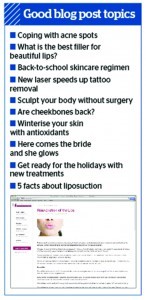Finding your voice
Blog posts should not be solely about rankings and page views. They need to resonate with your target audience, educate and inform, and ring true to your brand. Posts are even more effective when they contain video content, links, and photographs. This is where the blogging voice can be challenging to develop, especially if you have multiple people posting on the same blog. The options are to write every post yourself as the physician authority, in the first person, or to craft posts in the third person or ‘we’ voice from the clinic as an entity. Each post can also be identified by the individual author, such as the clinic manager, nurse, medical aesthetician, and others.
Blogs written in the practitioner’s voice need to sound real. Therefore, content must be accurate, neither misleading nor defamatory, and cannot violate any privacy laws or rules of professional conduct. Consider adding a disclaimer to your blog, as you should have on your website, specifying, ‘Content contained herein is not a substitute for a consultation with a medical doctor and should not be considered medical advice’. If you are unclear on the appropriate language to use, contact your solicitor or malpractice carrier for guidance to limit your liability.
Google is not the only game in town; in fact, an integrated social media approach can deliver more return on investment (ROI) in many instances than pure search engine marketing alone. In many cases, creating a blog as a microsite
that lives on its own under a new domain name can offer more marketing muscle than merely adding a blog to your landing page as an afterthought. For maximum effectiveness, blog content should also be leveraged on your Facebook page, Twitter, LinkedIn profile, and other social bookmarking sites used to share information.
Blog post format
There are a number of key elements that should be built into every blog domain and post, and they all play an important role in getting the most mileage from your blog. Remember that spelling and grammar count in blogging too.
Even if the user is just browsing educational content on the blog, make it easy for him/her to learn more about your clinic, doctors, products, and services by including navigation to primary business pages. You want to encourage readers to stay and read more. Make it easy to browse the available content by grouping by topic and/or content type such as video, infographic, and blog post.

More is not necessarily more when it comes to blog posts. Long posts created purely for the sake of extra words are not really effective; however, short blurbs that do not say much are also not so interesting to readers. If the post is too long, chances are visitors will not read through it all. You should write posts of the length that it takes you to communicate what you want to say. Not every post has to be the same word count. If the post contains visuals or links, you can also reduce the word count. Shorter entries allow you to write more posts, which is preferable for generating readership on search engines and with RSS, which is the acronym used to describe syndication of web content. In essence, RSS is a way to allow other sites to publish some of your website or blog content by registering the document with an RSS publisher. A user can then publish RSS-distributed content on their site.
In general, a good guideline is to make your blog posts no more than 600 words and no less than 250 words. The type of post that you are writing will often determine the most appropriate length. For example, if you are writing on your opinion of a new procedure, you may write more than if you are relating the details of a news item where you will link to the full story so the reader can find out more. If you have a lot to say on a particular topic, splitting a long post into a series of shorter posts can be a great way to keep readers coming back. They read the first part, and realise there will be more to come, so they will return to read the rest of it.
Your first paragraph should be both an introductory and summary section; introduce the reader to the reason for your post. The body of your blog should include links to your social networking platforms. You can also let viewers skim your content by previewing posts in parts. Make the preview extra clickable by including an image.



